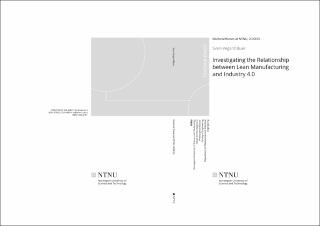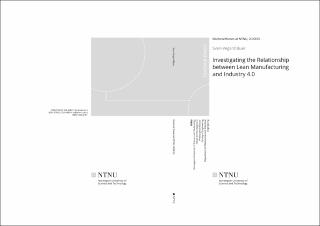| dc.contributor.advisor | Strandhagen, Jan Ola | |
| dc.contributor.advisor | Semini, Marco | |
| dc.contributor.advisor | Chan, Felix Tung Sun | |
| dc.contributor.author | Buer, Sven-Vegard | |
| dc.date.accessioned | 2020-03-20T10:50:02Z | |
| dc.date.available | 2020-03-20T10:50:02Z | |
| dc.date.issued | 2020 | |
| dc.identifier.isbn | 978-82-326-4483-4 | |
| dc.identifier.issn | 1503-8181 | |
| dc.identifier.uri | https://hdl.handle.net/11250/2647785 | |
| dc.description.abstract | Lean manufacturing has for more than two decades been the most prominent methodology for improving the operational performance in manufacturing companies. Originating from the Toyota Production System (TPS) (Ohno, 1988), lean manufacturing is built on the idea of eliminating waste in all forms by focusing on the activities that create value for the customer (Womack and Jones, 1996). It is a low-tech continuous improvement approach that focuses on employee empowerment and the streamlining of manufacturing activities. In parallel with the development of the TPS, computers also slowly started to emerge in manufacturing systems more than 50 years ago, both in processing and in planning and control of the operations (Klingenberg and Antunes Jr., 2017). Recently, the technology-oriented Industry 4.0 concept is being branded as the next enabler of performance improvement in manufacturing. The Industry 4.0 vision refers to networks of autonomous manufacturing resources that are sensor-equipped and selfconfiguring, and is enabled by the integration of a large number of different digital technologies (Kagermann et al., 2013). In general, this increased use of digital data and digital technologies is typically referred to as digitalization.
Lean manufacturing can work independently of information technology (IT) which by some has been viewed as a source of waste. Lean manufacturing utilizes decentralized control by giving local autonomy to the employees and emphasizes simplicity and transparency, whereas IT focuses on creating a centralized database, and IT systems are rigid, complex, and difficult to change and continuously improve (Åhlström et al., 2016). Although lean manufacturing and Industry 4.0 share the same objective of performance improvement, these underlying contradictory aspects might complicate a concurrent use.
As Industry 4.0 seems destined to overtake lean manufacturing’s position as the most prominent approach for performance improvement in manufacturing companies, several relevant issues should be investigated. The theoretical foundation of this thesis is positioned within the operations management research field and investigates the relationship between lean manufacturing and Industry 4.0. We will look further into whether lean manufacturing is an enabler or inhibitor for moving toward Industry 4.0 and if and how these two domains can complement each other. In addition to focusing on lean manufacturing and Industry 4.0, we also take a contingency research approach by investigating in which environments these two domains are appropriate.
The first research activity of this study was to conduct a systematic review of the existing literature on the relationship between lean manufacturing and Industry 4.0. After mapping the current research on this topic and identifying relevant research gaps, we defined three research questions. These are as follows:
1. What are the implementation patterns of both lean manufacturing and digital technologies across different production environments?
The first research question aimed at uncovering possible differences in the implementation level of lean manufacturing and that of digital technologies among different production environments. Additionally, we investigated whether there are any significant differences in implementation levels between different company sizes. To answer this research question, we conducted a survey to investigate the relationships between environmental factors (i.e., production environment and company size) and the implementation levels of both lean manufacturing and digital technologies.
2. What are the performance implications of a concurrent use of lean manufacturing and digital technologies?
The second research question sought to investigate the impacts on operational performance from using lean manufacturing and digital technologies. In addition to investigating the main (i.e., individual) effects of lean manufacturing and digital technologies on operational performance, their interaction effect was also investigated. The presence of a positive interaction effect suggests a synergistic effect greater than the main effects combined (Khanchanapong et al., 2014). To address this research question, we used survey data to analyze the relationship between the implementation levels of lean manufacturing and factory digitalization (i.e., the use of digital technologies for internal operations) and the corresponding operational performance.
3. How can digital technologies be used to support lean manufacturing?
While most lean manufacturing practices can work independently of IT, part of this research study focused on how the emergence of the digital technologies associated with Industry 4.0 may support and further develop existing lean manufacturing practices. Companies that have already implemented lean manufacturing need guidelines on how to react to the impacts of Industry 4.0 (Meudt et al., 2017) and directions on how emerging technologies can be integrated into existing lean manufacturing systems (Wagner et al., 2017). This research question aimed at investigating the potential of such emerging digital technologies, outlining their possibilities, and presenting different concepts and cases of how they can be integrated with established lean manufacturing practices. To address this research question, we used existing literature, conceptual development, and a case study to highlight examples where digital technologies associated with Industry 4.0 can be or have been used to support existing lean manufacturing practices.
Lean manufacturing and Industry 4.0 have been investigated individually, as well as together. This thesis presents contributions to both theory and practice, which can be summarized as follows:
• An integrated framework for mapping different production environments. This framework differs from earlier mapping frameworks in the way that it considers more variables, and the defined values for each variable make it more accessible and easy to use. We suggest that this is, among others, an excellent tool for comparison in multiple case studies where it is expected that environmental factors may influence the results and should be controlled for.
• New knowledge on the implementation patterns of lean manufacturing practices and of digital technologies across different production environments and company sizes. These results provide updated findings that can help us understand which parts of lean manufacturing and which digitalization aspects are universal, and which are contextdependent. Knowing the nature of these patterns is important to guide the development of implementation frameworks that take into account the characteristics of different production environments.
• Providing empirical results showing that both lean manufacturing and factory digitalization individually are related to improved operational performance. Investigating both simultaneously adds the additional methodological benefit of controlling for potential confounding effects. The findings also provide support for a complementary effect of lean manufacturing and factory digitalization on operational performance. Our results suggest that the operational performance benefits of implementing either lean manufacturing or digital technologies in isolation are relatively modest. The true operational performance advantage comes when both domains are implemented; in other words, their concurrent use produces a synergistic effect that is larger than the sum of their individual contributions.
• The presentation of concepts and cases of how digital technologies can support lean manufacturing practices. This contributes to research by illustrating how these two domains can complement each other. Further, we provide assessments on the benefits and drawbacks of such solutions, how digital technologies can address known limitations in existing lean manufacturing practices, and how it can contribute to improved operational performance.
• The data-driven process improvement cycle for mapping current digitalization levels, as well as planning and guiding improvement processes. In addition to clarifying some definitions surrounding the term digitalization, the data-driven process improvement cycle provides a structured method to map existing processes and identify possibilities for further digitalization.
The findings of this thesis also have several implications for practitioners, which can be summarized into the following recommendations:
• Our findings indicate that the implementation level of lean manufacturing is quadratically related to production repetitiveness, which means that the implementation level tends to be lower in production environments with very low or very high repetitiveness. Although implementation level does not equal applicability, these insights should be used by managers to adjust their targets, expectations, and approaches when implementing lean manufacturing instead of forcing through a standardized implementation program.
• The results of this study challenge the opinion that lean manufacturing and IT are incompatible. In fact, the results show that they tend to co-exist and mutually reinforce each other. That the greatest performance benefits are obtained when using lean manufacturing and digital technologies concurrently provides valuable insights when developing roadmaps for production improvement initiatives. With the promise of substantial performance improvements following an Industry 4.0 implementation, there might be the temptation to focus all attention on Industry 4.0 at the expense of lean manufacturing. However, our findings indicate that existing lean manufacturing systems should not be neglected but should rather be used as a basis for deploying new technologies into the manufacturing system.
• The presented concepts and cases of how lean manufacturing and digital technologies can be integrated can be used as inspiration for how to approach the fourth industrial revolution. We recommend using digital technologies to address known problems and limitations in the manufacturing system, rather than digitalizing simply for the sake of it.
• This thesis also presents several frameworks which should be useful for managers. Managers can use the framework for mapping production environments as a starting point for designing appropriate production planning and control solutions, comparing their operations with other companies, and identifying possible improvement areas. The data-driven process improvement cycle can be used to map the digitalization degree of current processes and provide guidance for how a higher degree of digitalization can be reached.
Overall, this thesis should provide a better understanding and knowledge of the relationship between lean manufacturing and Industry 4.0. This thesis aspires to support those who either manage or study these two domains, individually or in combination. | |
| dc.language.iso | eng | en_US |
| dc.publisher | NTNU | en_US |
| dc.relation.ispartofseries | Doctoral theses at NTNU;2020:65 | |
| dc.relation.haspart | Paper 1:
Buer, Sven-Vegard; Strandhagen, Jan Ola; Chan, Felix T.S..
The link between Industry 4.0 and lean manufacturing: mapping current research and establishing a research agenda. International Journal of Production Research 2018 ;Volum 56.(8) s. 2924-2940
- The final authenticated version is available online at:
https://doi.org/10.1080/00207543.2018.1442945 | |
| dc.relation.haspart | Paper 2:
Buer, Sven-Vegard; Strandhagen, Jo Wessel; Strandhagen, Jan Ola; Alfnes, Erlend.
Strategic Fit of Planning Environments: Towards an Integrated Framework. Lecture Notes in Business Information Processing 2018 ;Volum 262. s. 77-92
- The final authenticated version is available online at: https://doi.org/10.1007/978-3-319-73758-4_6 | |
| dc.relation.haspart | Paper 3:
Buer, S.V., Alfnes, E., Semini, M. & Strandhagen, J.O. (2019), “New insights on the relationship between lean manufacturing practices and type of production environment”
- this paper is awaiting publication and is not included in NTNU Open | |
| dc.relation.haspart | Paper 4:
Buer, S.V., Strandhagen, J. W., Semini, M. & Strandhagen, J.O. (2019),
“The
digitalization of manufacturing: investigating the impact of production environment
and company size”
- this paper is awaiting publication and is not included in NTNU Open | |
| dc.relation.haspart | Paper 5:
Buer, S.V., Semini, M., Strandhagen, J.O. & Sgarbossa, F. (2019),
“The
complementary effect of lean manufacturing and digitalisation on operational
performance: results from a survey of Norwegian companies”
- this paper is awaiting publication and is not included in NTNU Open | |
| dc.relation.haspart | Paper 6:
Buer, Sven-Vegard; Fragapane, Giuseppe; Strandhagen, Jan Ola.
The data-driven process improvement cycle: Using digitalization for continuous improvement. IFAC-PapersOnLine 2018 ;Volum 51.(11) s. 1035-1040
- The final authenticated version is available online at:
https://doi.org/10.1016/j.ifacol.2018.08.471 | |
| dc.title | Investigating the Relationship between Lean Manufacturing and Industry 4.0 | en_US |
| dc.type | Doctoral thesis | en_US |
| dc.subject.nsi | VDP::Teknologi: 500::Maskinfag: 570 | en_US |
| dc.description.localcode | Digital full text not available | en_US |

